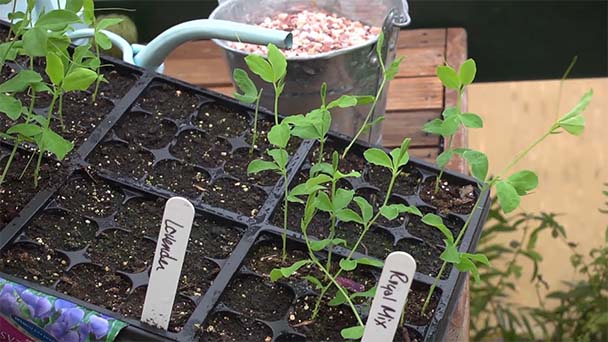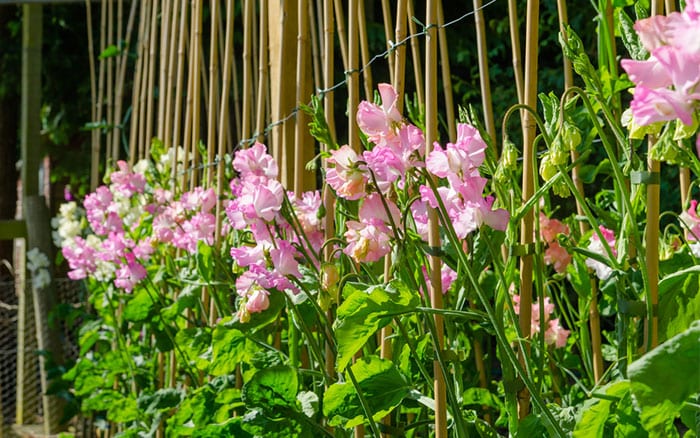Growing sweet peas indoors
Written by Joy
Oct 22 2021

Growing sweet peas indoors is a favorite in cottage gardens and other informal garden styles. The most often seen is to cultivate bamboo piles or structures, but it can also be left to form a pile or planted in a container, and it overflows to the sides. For many of us, sweet pea is a nostalgia for the beautiful, noisy garden maintained by our grandparents. Sweet peas are very easy to grow, and they provide a season-long color, as long as the buds are removed routinely.

Sweet peas are climbing plants. It has flower clusters of various colors, including red, pink, blue, white and lavender. Sweet peas are the season when the flowers bloom in early summer, and they make excellent cut flowers. These flowers resemble fringed butterflies, and their stems are folded. Fortunately, the stems are strong enough to hold their abundant flowers.
Old-fashioned varieties are selected for their bright colors and strong aroma. Many modern varieties offer sweet peas in almost all colors except yellow, but not all new sweet pea varieties are fragrant. The size of the maturity will depend on the variety you choose to plant, but you could expect the vines to stretch to at least 6 to 8 feet tall.
Unlike other types of this genus, sweet peas are poisonous and the seeds should not be ingested by humans or pets.
Sweet peas are usually live. To aid germination, the seeds should be scratched by cutting and/or soaking in water for several hours to soften the seed coating. The sweet peas seeds can start outdoors, once the ground temperature rises to about 50 degrees Fahrenheit and is not too wet. You can start the season by starting seeds indoors, approximately 4 to 5 weeks before the last frost date. If you start them with peat, they will be easier to transplant. When you are ready to transplant, pluck out any flowers or buds that may have formed to encourage root development. Sweet peas like cool soil, so a thick layer of fertilizer around the plants can help sweet peas thrive.
When the plant is 3 to 6 inches tall in the garden, you can pinch the seedling to encourage strong side shoots. Sweet pea vines have tendrils and attach themselves to most supports of any type with meshing or stringing.
During the growing season, sweet peas need to be stable, fed and watered frequently. You ought to feed them with high potassium fertilizers such as tomato fertilizer every month. Adding a little blood meal to the soil is thought to help keep the stems long and suitable for cutting.
Most sweet pea varieties will begin to bloom in late spring or early summer. The more flowers you should get the most flowers, so you'd better not hesitate to bring some bouquets indoors. It's a good choice to use dead flowers to encourage continued blooming. You should avoid growing sweet peas in the same location year after year.
Old-fashioned: Although it is not a variety, the old-style sweet peas should be very fragrant.
Spencer varieties: These particularly hardy vines have striking colors, but not all grapes are particularly fragrant.
Bijou Group: Sweet peas is a sweet dwarf variety suitable for container use.

Sweet peas are climbing plants. It has flower clusters of various colors, including red, pink, blue, white and lavender. Sweet peas are the season when the flowers bloom in early summer, and they make excellent cut flowers. These flowers resemble fringed butterflies, and their stems are folded. Fortunately, the stems are strong enough to hold their abundant flowers.
Old-fashioned varieties are selected for their bright colors and strong aroma. Many modern varieties offer sweet peas in almost all colors except yellow, but not all new sweet pea varieties are fragrant. The size of the maturity will depend on the variety you choose to plant, but you could expect the vines to stretch to at least 6 to 8 feet tall.
Unlike other types of this genus, sweet peas are poisonous and the seeds should not be ingested by humans or pets.
Sweet peas informationSweet peas landscape useGrow sweet peas indoorsSuggested varietiesPests and problems for growing Sweet peas indoors
Sweet peas information
Sweet pea is a climbing member of the legume plant. The sweet peas, which originated from southwestern Italy and the Mediterranean islands, have been cultivated for garden use since the 17th century, but it reached a modern form under the work of the Scottish nurseryman Henry Ekford, who developed dozens of them in the late 19th century Kinds of cultivars.Sweet peas landscape use
Sweet peas bring a bungalow feel to the garden. Sweet peas are usually grown on a bamboo tripod, but they will happily grow through shrubs, just like clematis are sometimes used. Sweet peas also work well in vegetable gardens, attracting bees and other pollinators needed in vegetable gardens. They can be grown along fences or mixed with stem beans. Sweet peas can also grow in clusters of mounds, and their height will reach about 2.5 feet.Grow sweet peas indoors
Calculated by year, sweet peas can be grown in all cold hardy areas of the United States Department of Agriculture, although they work best in relatively cool summer climates. Sweet peas thrive in full sunlight, but in warm climates, they perform well in locations that receive partial sunlight, especially in the hot afternoon. In the south, you might have better luck planting sweet peas in the fall to grow into winter. Sweet peas like strong, well-draining soil. A weakly alkaline (approximately 7.5) soil pH is ideal for sweet peas.Sweet peas are usually live. To aid germination, the seeds should be scratched by cutting and/or soaking in water for several hours to soften the seed coating. The sweet peas seeds can start outdoors, once the ground temperature rises to about 50 degrees Fahrenheit and is not too wet. You can start the season by starting seeds indoors, approximately 4 to 5 weeks before the last frost date. If you start them with peat, they will be easier to transplant. When you are ready to transplant, pluck out any flowers or buds that may have formed to encourage root development. Sweet peas like cool soil, so a thick layer of fertilizer around the plants can help sweet peas thrive.
When the plant is 3 to 6 inches tall in the garden, you can pinch the seedling to encourage strong side shoots. Sweet pea vines have tendrils and attach themselves to most supports of any type with meshing or stringing.
During the growing season, sweet peas need to be stable, fed and watered frequently. You ought to feed them with high potassium fertilizers such as tomato fertilizer every month. Adding a little blood meal to the soil is thought to help keep the stems long and suitable for cutting.
Most sweet pea varieties will begin to bloom in late spring or early summer. The more flowers you should get the most flowers, so you'd better not hesitate to bring some bouquets indoors. It's a good choice to use dead flowers to encourage continued blooming. You should avoid growing sweet peas in the same location year after year.
Suggested varieties
There are many wonderful varieties of sweet peas that can be used as seeds. You can pack various colors or mix colors. What you should keep in mind is that you'd better not all sweet peas are fragrant, so be sure to check the packaging.Old-fashioned: Although it is not a variety, the old-style sweet peas should be very fragrant.
Spencer varieties: These particularly hardy vines have striking colors, but not all grapes are particularly fragrant.
Bijou Group: Sweet peas is a sweet dwarf variety suitable for container use.
Pests and problems for growing Sweet peas indoors
There are few pests or problems related to sweet peas, however groundhogs and rabbits eat these seedlings, so when they first enter the ground, it is a good idea to protect them with spray. Almost no insects bother sweet peas. But if the temperature is too high, plants may enter dormancy.Check our article on 35 Most Common House Plants with Pictures & Care Guide
Latest Updated
- Benefits of Bugleweed - 7 Science-backed Health Benefits
- Bugleweed Dangers & Side Effects - Is It Poisonous?
- How to Plant Evergreen Trees - What You Should Know
- When to Plant Evergreens - Grow Guide for Evergreen Trees
- 12 Wonderful Evergreen Shrubs for Your Garden
- 12 Popular Evergreen Plants with Pictures for Beginners
- When And How To Prune A Lilac Bush Like a Pro
- How to Grow & Care for Lilac Vine (Hardenbergia Violacea)
- Japanese Lilac Tree (Syringa Reticulata) Care & Propagation Guide
- Shumard Oak Pros and Cons - What to Know
Popular Articles
- Winter maintenance of Antirrhinum Majus
- How to Grow Terminalia Mantaly Tree
- How to Grow and Care for Crossostephium Chinense
- How to grow Antirrhinum Majus in spring
- Peristeria Elata (Dove Orchid) Profile: Info & Care Guide
- Underwatered Snake Plant (Sansevieria Trifasciata) - Signs And How To Fix
- How to Care for Brazilian Jasmine Plant (Mandevilla Sanderi)
- How to Grow & Care for Graptopetalum Purple Delight in Summer
- Rosa Chinensis (China Rose): Plant Growing & Care Tips
- How to Care for Baby Sun Rose (Aptenia Cordifolia)